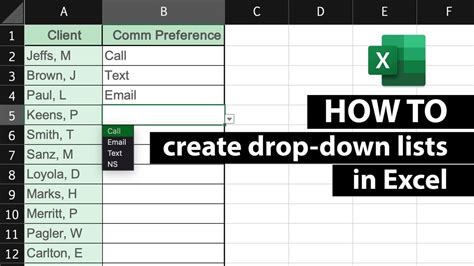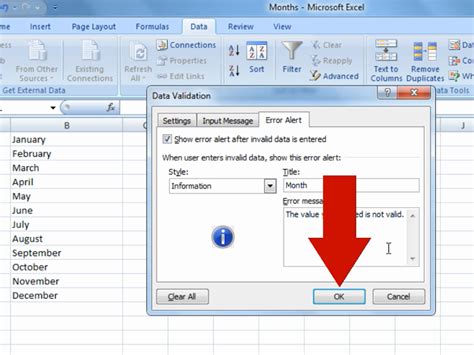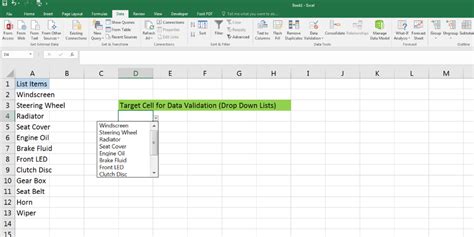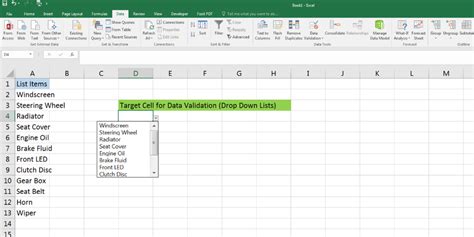Inserting a drop-down list in Excel can significantly enhance the functionality and user experience of your spreadsheet. This feature allows you to create a list of items from which users can select, making data entry more controlled and reducing errors. To effectively utilize this tool, it's essential to understand the steps involved in creating and implementing a drop-down list in Excel.
Understanding the Basics of Drop-Down Lists in Excel

Before diving into the process, it’s crucial to grasp the basics. A drop-down list, also known as a dropdown or pull-down menu, is a graphical control element that allows users to choose an option from a list of predefined items. This feature is particularly useful for limiting input to specific choices, thereby maintaining data consistency and accuracy.
Benefits of Using Drop-Down Lists
The benefits of incorporating drop-down lists into your Excel worksheets are multifaceted. They help in:
- Reducing data entry errors by limiting choices to predefined options.
- Enhancing user experience by providing a clear and concise way to select from a list of items.
- Improving data analysis and reporting by ensuring that data is consistent and easily categorizable.
Step-by-Step Guide to Inserting a Drop-Down List in Excel

To insert a drop-down list in Excel, follow these detailed steps:
Step 1: Prepare Your Data
First, you need to prepare the list of items you want to include in your drop-down list. This list should be placed in a column or row without any blank cells in between the items. For example, if you want a list of colors, your data might look like this:
| Colors |
|---|
| Red |
| Blue |
| Green |

Step 2: Select the Cell for the Drop-Down List
Select the cell where you want the drop-down list to appear. This could be any cell in your worksheet where you want to restrict input to your predefined list.
Step 3: Go to Data Validation
Navigate to the “Data” tab in the Excel ribbon, then click on “Data Validation” in the Data Tools group. This will open the Data Validation dialog box.
Step 4: Set Up the Data Validation
In the Data Validation dialog box, under the “Settings” tab, select “List” from the “Allow” dropdown menu. Then, in the “Source” field, you need to specify the range of cells that contains your list. You can either type the range (e.g., $A$1:$A$3 if your list is in cells A1 through A3) or select the range by clicking on the icon at the right end of the “Source” field and then selecting the cells.
Step 5: Apply the Validation
After specifying the source range, click “OK” to apply the data validation. Your selected cell will now have a drop-down list that appears when you click on it, containing the items from your specified range.
Tips for Working with Drop-Down Lists in Excel
For a more effective use of drop-down lists, keep the following tips in mind:
Managing Large Lists
Updating Drop-Down Lists
If you need to update the items in your drop-down list, simply modify the source range, and the changes will be reflected in the drop-down list.
Using Drop-Down Lists with Other Excel Features
Drop-down lists can be combined with other Excel features, such as conditional formatting or formulas, to create more dynamic and interactive spreadsheets.
Key Points
- Prepare your list of items in a column or row without blank cells.
- Select the cell where you want the drop-down list to appear.
- Use Data Validation to set up the drop-down list, specifying the source range.
- Apply the validation to create the drop-down list.
- Consider the size and complexity of your data when setting up drop-down lists.
By mastering the use of drop-down lists in Excel, you can significantly improve the functionality and usability of your spreadsheets, making data entry more efficient and reducing the likelihood of errors.
How do I update the items in my drop-down list?
+To update the items in your drop-down list, simply modify the source range. If you've added or removed items, ensure your source range in the Data Validation settings reflects these changes.
Can I use drop-down lists with other Excel features?
+Yes, drop-down lists can be used in conjunction with other Excel features such as conditional formatting, formulas, and even macros, to create more complex and interactive spreadsheets.
How do I deal with very large lists?
+With practice and experience, you’ll find that drop-down lists become an indispensable tool in your Excel arsenal, enabling you to create more sophisticated, user-friendly, and data-accurate spreadsheets.



